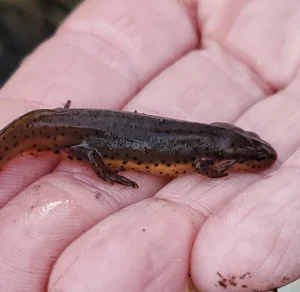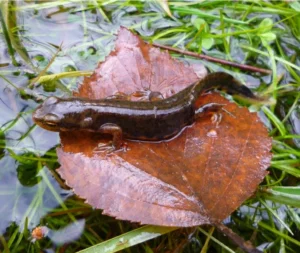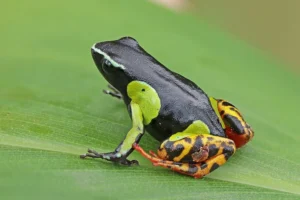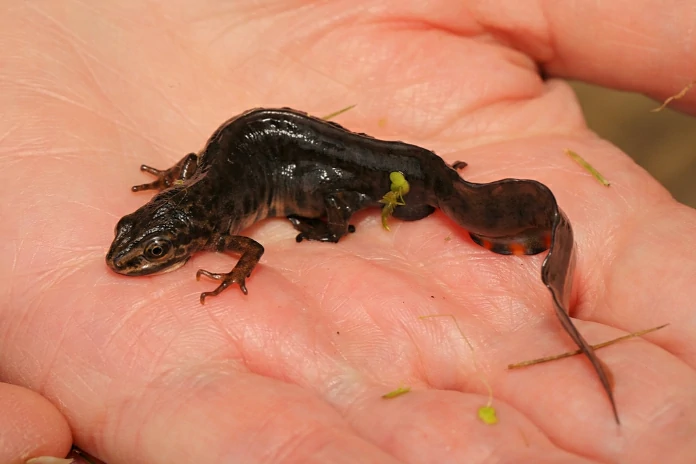Have you ever picked up a newt and noticed how slippery it feels? That slimy texture isn’t just for show, it actually helps the newt stay alive. But what’s really happening here, and why does their skin feel so slimy in the first place?
Yes, newts have slimy skin, and that slime does many important jobs. It keeps them moist, helps them breathe, protects them from germs, makes them harder to catch, and even stops predators with toxins.
Once you understand what it does, that slippery coat looks less like something “gross” and more like one of nature’s clever designs.
Why Newts Feel Slimy When You Touch Them
The first time someone picks up a newt, most people react the same way, surprised at just how slippery it feels. Some laugh, some pull back quickly, and others just watch in interest.

Newts don’t have scales like fish or dry, tough skin like reptiles. Their skin is thin and soft, covered in a wet layer of mucus. That mucus is the slime you feel.
It’s not just water. It’s a mix of proteins, salts, and chemicals that give it protective powers.
To touch, it might feel strange, but for the newt, it’s the difference between life and death.
The Jobs of a Newt’s Slimy Skin
Slime might seem simple, but for newts it works like a multi-tool. Every layer of mucus is doing something useful:
-
Keeps them from drying out – Their thin skin loses water quickly, and slime acts like a seal.
-
Helps them breathe – Oxygen can pass through slimy skin, giving them another way to get air.
-
Stops germs – The mucus has chemicals that fight infections.
-
Protects against predators – Some slime tastes bitter or has toxins that make predators spit them out.
-
Helps escape – A slippery body is much harder for predators to hold.
Basically, the slime is a survival shield. Without it, a newt couldn’t last long in its damp but risky world.
Why Moisture and Slime Matter for Newts
Unlike us, newts don’t have thick skin to hold in water. Their skin is like a thin layer, open to the environment. If they dry out, they won’t last long.

That’s why you rarely see newts crawling around in bright sun. They come out after rain, during cool evenings, or along damp forest floors.
Their slime makes sure the moisture they get from their surroundings doesn’t disappear too fast.
Imagine walking through a forest after a spring shower. You might see a newt crossing the trail, its skin shining under the dim light.
That shine isn’t just rain, it’s their protective coat working hard to keep them alive.
Do Newts Breathe Through Their Slimy Skin?
Here’s an interesting fact: newts don’t just breathe with their lungs. They also breathe directly through their slimy skin.
This process, called cutaneous respiration (which means getting oxygen directly through the skin), only works if the skin stays wet.
The slime keeps it ready, letting oxygen pass into their blood and carbon dioxide pass out.
If their skin dries, this breathing stops. That’s why handling them with dry hands or keeping them away from water can be dangerous, the loss of slime literally takes away their ability to breathe.
How Slimy Skin Protects Newts From Predators
Newts are small, and their world is full of creatures that would happily eat them, birds, fish, snakes, even raccoons. Being slimy is their secret trick.
First, the slipperiness makes them harder to grab. Imagine trying to hold a bar of soap in running water.

That’s what it feels like for a predator trying to hold a newt.
Second, the slime often tastes bad. Some species even add toxins to their slime, making predators regret the bite.
The rough-skinned newt of North America, for example, produces tetrodotoxin, one of the strongest natural poisons on Earth.
Many predators have learned to leave these slimy creatures alone.
How Slimy Skin Protects Newts From Germs
Newts don’t just face big predators, they also face tiny invaders like bacteria, fungi, and parasites. Living in damp places makes them especially at risk.
Their slime works like a shield. It has chemicals that fight infections before they start.
Scientists have even studied amphibian slime for possible use in human medicine. Some compounds could help fight germs that resist normal antibiotics.
So when you see a slimy newt, you’re looking at more than a protective coat, you’re looking at a natural pharmacy built right into its skin.
How Slimy Skin Helps Newts Move
Watch a newt swim, and you’ll notice how smoothly it glides. Their bodies cut through water with little resistance.
That’s partly because of their shape, but slime plays a role too. It reduces drag, letting them slip through water more easily.
On land, it helps as well. The slippery layer reduces friction against leaves, soil, and rocks, letting them wriggle into hiding spots quickly.
Think of it like the sleek suits Olympic swimmers wear. For newts, slime is both speed and safety.
Do All Amphibians Have Slimy Skin?
Newts are salamanders, and like their cousins, they share the slimy trait.
Frogs also have slimy skin, though toads usually look drier because their bumpy skin holds moisture better inside.

Compared to frogs, newts depend even more on slime because of their lifestyle.
They switch between land and water through their lives, and their skin has to handle both worlds.
That slimy coating is what makes the balancing act possible.
Slimy Skin Doesn’t Mean Dirty Skin
People often think slime equals dirty. But really, newt slime is the opposite. It’s clean, protective, and balanced.
Just like fish in a tank get sick if they lose their slime coat, newts rely on theirs to stay healthy.
The mucus is constantly renewed, flushing out dirt and stopping harmful germs.
What looks slimy to us is, for them, a built-in health system.
What Happens if a Newt Loses Its Slimy Coat?
If a newt loses its slime, it’s in serious danger. Without that coat, it dries out faster, can’t breathe through its skin, and becomes easy prey for infections.
This often happens when people remove newts from their natural homes or handle them too much.
Oils, soaps, or chemicals from our skin can break down their mucus.
That’s why experts always say to watch, not capture. A newt without slime is like a knight without armor, defenseless.
Can a Newt Survive if Its Skin Dries Out?
The simple answer is no, not for long. A dried-out newt can’t breathe through its skin, can’t hold in moisture, and quickly weakens.
In dry or hot weather, newts hide in damp places: under logs, in burrows, or buried in mud.
Some even go dormant until rain comes back. But if their slime is gone completely, survival becomes almost impossible.
Conclusion
So, do newts have slimy skin? Yes, and that slime is their ultimate survival tool. It keeps them moist, lets them breathe, heals wounds, blocks germs, and stops predators.
Next time you see a newt gliding through water or crawling across wet leaves, don’t think “gross.”
Think about how that slimy coat is the reason such a fragile creature can live such a bold life.
The slime isn’t just a feature, it’s the secret superpower that lets newts survive in both water and on land.
Hi, my name is Ezra Mushala, i have been interested animals all my life. I am the main author and editor here at snakeinformer.com.

